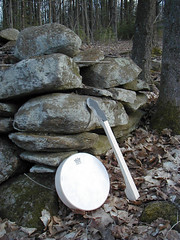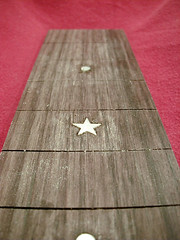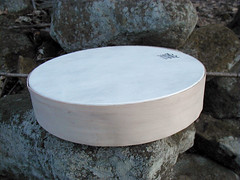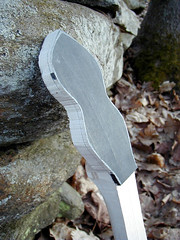Tenor #1: Neck, Part IX
I think everything went well... now it's a matter of sanding, then sanding, then sanding some more.
It's a good thing I'm not planning on selling this particular instrument when it's finished. It's a detail that will always bug me a little bit, but not quite enough to throw out the fingerboard.
Postscript
While playing guitar tonight I noticed that the marker is indeed on the ninth fret. Interesting. I'll have to cross-reference tenor guitars and mandolins too.
 If I had to guess how much time I've put into this tenor banjo, it would not actually be very much compared to the number of weeks that have passed... maybe 15 hours altogether. Today was the first time in about a month that I've managed to find a number of consecutive hours to work on it, and I got a tremendous amount done.
If I had to guess how much time I've put into this tenor banjo, it would not actually be very much compared to the number of weeks that have passed... maybe 15 hours altogether. Today was the first time in about a month that I've managed to find a number of consecutive hours to work on it, and I got a tremendous amount done.
 I finally summoned the courage to cut into my pristine piece of rosewood. I built a small miter box last month, and it seems to have worked fairly well. I'll know better when the time comes to actually install the frets.
I finally summoned the courage to cut into my pristine piece of rosewood. I built a small miter box last month, and it seems to have worked fairly well. I'll know better when the time comes to actually install the frets. In the end I decided to use the full 2 inch width of veneer. In an attempt to avoid ironing directly against the edge of the drumhead, I first tried ironing the veneer agains a length of parchment paper. My theory was that the glue would melt without sticking, and I would be able to peel it up and apply it directly to the drum.
In the end I decided to use the full 2 inch width of veneer. In an attempt to avoid ironing directly against the edge of the drumhead, I first tried ironing the veneer agains a length of parchment paper. My theory was that the glue would melt without sticking, and I would be able to peel it up and apply it directly to the drum. I had done a fair amount of shaping on the neck since the last photo, and I decided it was time to shape the peghead before continuing.
I had done a fair amount of shaping on the neck since the last photo, and I decided it was time to shape the peghead before continuing.